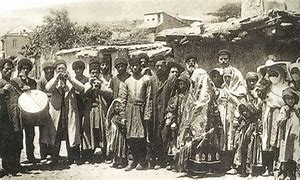The war in Gaza and the (new) anti-Semitic pogroms in the North Caucasus
The conflict between Israel and Hamas has led to "Jew-hunting" in Dagestan. This event is astonishing because there were no significant precedents of aggression in the past. The various ethnic-religious groups in the area coexisted without mixing, but avoiding fuelling disputes or tensions. Memory distorted by propaganda.
Moscow (AsiaNews) - The anti-Semitic pogroms in Dagestan in recent days have sparked astonishment, as there are no particularly significant precedents in the region for aggressive riots against Jews.
The agitated demonstrators searched for Jewish refugees from Israel in hotels and airports, but actually found none; even on the flights from Tel Aviv there were only Russian citizens or other nationalities, but no Israelis or people openly of Jewish nationality.
This raised many questions, while Russian President Vladimir Putin even accused Ukraine and the West of organizing the provocation. However, others have wondered what the roots of the Jewish presence in the Caucasian territories are.
The Jews of the Caucasus are even mentioned in the Chronicle of Nestor, the annalistic account of the origins of Kievan Rus'. Inside it is said that Prince Vladimir refused to accept the Jewish religion proposed by the Khazars because they were "outside their promised land", finally choosing Byzantine Baptism to create the new holy land of Kiev.
In Dagestan, a region with a complex geographical relief, the Gorskye Eward, the "mountain Jews", have existed since ancient times, whose origins remain mysterious, but had never given rise to extreme ethnic hostility.
Historians also call this group the Taty, according to a generic name for the population of Iranian stock in the Caucasus region, with a more denigrating meaning on a social level than a decisive one on an ethnic level. It indicated the peasant serfs, at the service of the feudal Turks, united by the language, but of different religious traditions.
The majority has always been made up of Muslims, and identifies mainly with the community of Azeris, the "different brothers" of the Iranians. There were also the "Armenian Taty", who used a dialect of the same language, but professed the apostolic Christian faith of Armenia.
And there was also the Jewish minority, also with its own dialect variations, partly still existing in the Dagestan mountains, so much so that they were the main witnesses of that mass of cultural and social expressions.
The various ethno-religious groups in this area have always been endogenous, trying not to mix with each other, but without provoking conflicts. In Soviet times the nationality was indicated in the passport, and all the Muslims in the area were marked as Azerbaijanis, while the Gorskys were indicated as Jews, concentrated in what later became the republic of Dagestan, prevailing in numbers over the others in the high villages .
It was post-war Soviet policy that instilled explicit elements of anti-Semitism, so much so that in 1949 a group of Gorsky intellectuals asked the authorities for clarification, ensuring that the Jewish root was not in conflict with the lines of Soviet ideology.
From that moment on in the passports all the inhabitants of the area were marked generically as Taty, and from Dagestan this usage was also applied to the other republics of the North Caucasus, Chechnya, Kabardino-Balkaria and other places where the Gorskys lived.
This allowed Caucasian Jews to live relatively in peace, within a polyethnic group that remained quite distant even from the Chechen wars that broke out after the end of the USSR, and from the many subsequent conflicts.
Until the current global projection of the clash between Palestinians and Israelis, which led to the "Jew hunt" in Dagestan; the attackers, inspired by external and distant events, actually struggled to find Jews in hotels and airports, as the real ones were distant and isolated.
The origin of the Gorsky Jews remains largely a historical enigma, their current persecution cannot be explained by local factors; memory is distorted by propaganda, wherever it comes from, destroying the harmony of small and large worlds at all latitudes, and between continents.
07/08/2025 09:40
27/04/2023 09:20
21/09/2021 10:32
08/09/2021 10:22







.png)










